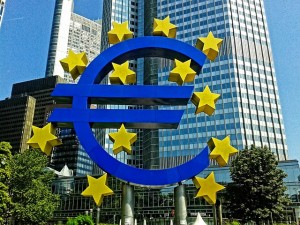This week the institutions that manage world countries’ currency such as the European Central Bank and the Federal Reserve had  their hopes for economic improvement dashed. The market continued to go down the path of uncertainty and quick (but not true) fixes to the downward spiral, further cementing an apparent preference to sweep financial catastrophes under the rug.
their hopes for economic improvement dashed. The market continued to go down the path of uncertainty and quick (but not true) fixes to the downward spiral, further cementing an apparent preference to sweep financial catastrophes under the rug.
The stock market continued to decline this week bringing losses to nearly 8 percent for the last month. The value of the U.S. dollar declined and American bond prices spiked following financial information from the U.S. (retail sales and production reports) and China (weak inflation) that raised concerns that the global economy is looking even more dire than thought before.
At first this recent downturn was made to seem less detrimental than it actually is by those who influence stock market policies. In actuality, one could view this change as healthy, breaking up the stagnation that had some market-watchers wondering if the market had become too ignorant to threats in current global events.
However, the amplifying of this sell-off that has caused a fall in prices might have given central banks a jolt by increasing the possibility of this change in the market moving too quickly which could impair boldness in shoppers and cause a slowdown in spending. It is being compared to the 2008 banking crisis, where buyers, fearing that the world economy was going into a depression, made a switch over to quality.
The question is how (and how soon) the central banks of the world that influence policy will react to this stock market downturn. In the past few days investors have delayed their expectation of a federal rate increase from the summer of 2015 to the winter of 2015 or early 2016.
The financial meltdown in 2008 made central bankers spearhead a mission to save the world economy by lowering rates and feeding trillions into the global economy, and buying government debt, for example. When central bankers met at the International Monetary Fund meetings last week central bankers seemed at ease that they had accomplished their goals and encouraged governments to contribute by increasing demand and employment by putting money into infrastructure.
All over the globe central banks have faced the same questions: is the current fluctuation a ripple effect from chaotic world events or possible fears, or is the world economy actually going deeper into failure? Nations that have flexibility having been taking advantage of it with central banks already. Some are lowering their interest rates while others are dispensing stimulus relief. The world nations with less flexibility such as America, England, Japan and the European Central Bank which have been held to different standards are going to have a harder time. England and the U.S. wanted to raise interest rates because when they are not collecting enough interest, coming up with alternative ways to aid the decline is difficult. The U.S. is also interested in more asset purchasing if the economy keeps getting worse, but the hope is that the United States will bolster through the international economic storm and lift interest rates in 2015.
The European Central Bank and the Bank of Japan are experimenting with conduct that is getting a variety of results, with the European Central Bank advocating for European nations to contribute by increasing their spending. The Federal Reserve gathers at the end of October and intends to terminate its bond-buying initiative then. Spectators will be watching for hints of where the Federal Reserve’s thoughts are about global occurrences. With quite a bit of global turmoil recently it is unclear how things will end up, but it does give central banks and financial institutions even more food for thought in chaotic times.

















